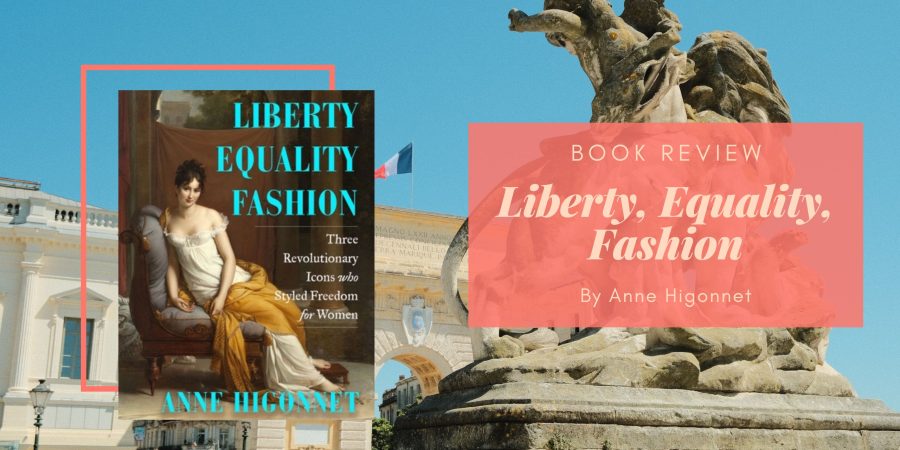Head’s up: this review is by someone who really only knows the very bare basics of the French revolution. I’m basically heading into this as a newbie, and this is also why I found the book fascinating.
Liberty, Equality, Fashion traces the path of three women who made an out-sized fashion (and societal) impact during and after the French revolution:
- Joséphine de Beauharnais
- Thérésa Cabarrus/Madame Tallien
- Juliette Récamier
Of the three women, I’ve only heard of Joséphine de Beauharnais before and that’s mostly because she was married to Napoleon, so it was a pleasure to find out more about all three of them. What I’ve learnt is that from Thérésa’s experience during the Terror and from Josephine’s experience growing up in a French colony, the two likely collaborated together to come up with the revolutionary style of dress. And what Juliette did was to innovate it further in her salon.
Revolutionary dress went beyond breaking sumptuary codes. It was a blend of many different cultural influences, all capable of generating outrage, but dressed up in a veneer of classicism that made it acceptable:
“A dress worn without stays or petticoats was sure to be outrageous. A dress modeled on the clothing of people Europeans considered racially inferior was inconceivable. A garment borrowed from men would be illegal. But this was where the rage for classicism covered a multitude of sins. Europeans were so convinced of the natural superiority of their classicism that they were not going to identify the true origins of revolutionary dresses. They would see the Bengali muslin, the humbler indienne cottons, the Antilles gole, the jamdani and chikandari embroidery, the jama cut, the patka location of a waistline, and all they would recognize was their own classicism. The elimination of stays and petticoats would be impossible to ignore, but it would be mitigated by classicism, with just enough outrage left over to attract the attention Térézia and Joséphine hoped for.“
More than that, revolutionary clothes gave a woman freedom. Previous styles of dress were restrictive, literally immobilising noble women. As Higonnet writes: “The wealthier a woman was, the more elaborately her clothing confined her, so any personal power a woman accrued from rank was counteracted by her costume. Revolutionary fashion was resisted not despite its comfort, or despite the mobility it granted women in public. Revolutionary fashion was resisted because of its comfort, and because of the mobility it granted women in public.” Even accessories like handbags and hats were radical because they helped women get out of the home, instead of being purely decorative and keeping them at home.
We also see that fashion and politics have been intertwined for a long time, as seen from the fashion magazine Journal des dames et des modes. According to Higonnet, “Pro-woman, borderline-feminist positions dominated editorial pieces. The fiery women’s rights author Albertine Clément-Hémery, notably, was on the editorial board. On the very first page of the first issue, the Journal announced: “The degree of civilization to which a people has arrived can only be judged by the respect it gives to its women. This thermometer is infallible.””
Like I mentioned at the start, I’m not an expert in the period. I did look up our three main protagonists after reading the book and I found out that:
- The book says Thérésa styled herself Térézia – however, if you search by Térézia you might not get anything online
- The book also takes Juliette’s marriage to her husband as fact, but I did see on Wikipedia that it is disputed
So with all that in mind, and also remembering that history books like to tell stories (my takeaway from Inventing the Renaissance) I’m taking this book as the starting point for the story of fashion and the French revolution, and that it tells us about how we can view the relationship between fashion and feminism in the West. It isn’t the last word on the subject and I will be very interested in reading more books on this topic to continue learning more and broadening my perspective.

This sounds like a really interesting introduction to the topic and seems to be a decent place to start research
Right?? I’m not very familiar with French history but this is fascinating and I think it would be fun to draw parallels with Republic-era Chinese fashion (ie birth of the Cheongsam)
Nice review. I was struck by this quote:
“The degree of civilization to which a people has arrived can only be judged by the respect it gives to its women. This thermometer is infallible.””
It would appear then that the US “civilization” is in decline, as its current government appears hell bent on diminishing women’s autonomy over their own bodies and forcing women out of high level government positions solely because of their sex and therefor believed to be DEI (diversity, equity and inclusion) hires!
I think she gave a good thermometer! It’s hard to believe some of the news coming out of the US nowadays…